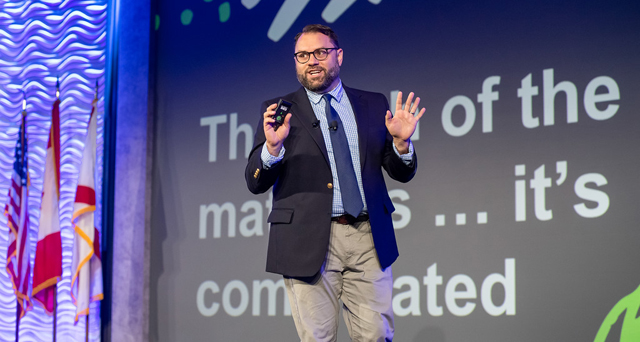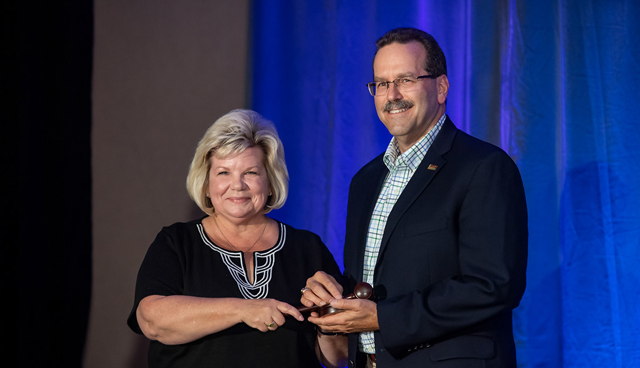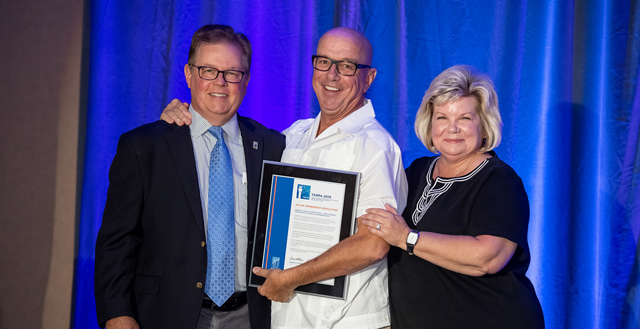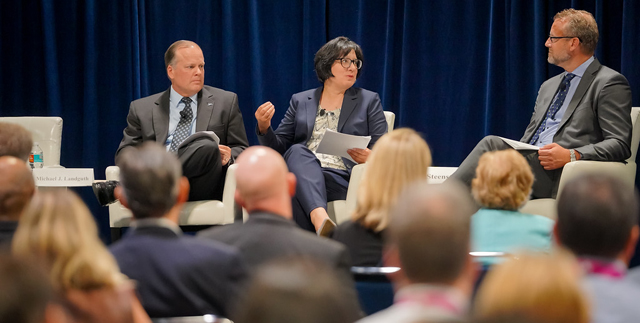
“The information space today is so complicated,” said Aaron Sharockman, Executive Director, Politifact, when leading off his keynote on Tuesday at General Session 2. “Everyone who has a phone can act like a journalist.” So the challenge becomes figuring out which news is legitimate. In an era of fake news, we are continually challenged as we separate fact from fiction, said moderator Sam Samaddar, Director, Kelowna International Airport.
Sharockman illustrated the difficulty of completing this task with a few rounds of “Real or Fake?” that were funny – but also scary. The man who supposedly took a solo flight on Delta. A dog who was rescued in a canal by a dolphin. A principal who banned candy canes. All were “real” stories, at least partially. What made them complicated was that parts of the story were real, and parts were not. It was the videos that added to the credibility, though, as they were the ones that were most believable. “This is something that keeps me up at night,” said Sharockman. “We believe things we see with our eyes. That is a big problem.” Case in point: The video featured with the dolphin-rescued dog was actually from a movie. It had nothing to do with the dog rescue.
So, how can you decide which posts are legitimate? With the “deep fakes,” Sharockman said to look for inconsistencies around the mouth, weirdness around the eyes or neck and problems with the audio. The “cheap fakes,” the ones that use manipulated or distorted video to reach misleading conclusions, can be tougher to spot. So, a good rule of thumb is to be skeptical of everything we see, in news feeds, particularly.
You can also fight back against misleading information. While there is no silver bullet, the answer is simple: “We need to get people to use their brains.”
Sharockman suggested using Wikipedia as a good place to go to source information. Also, you can do a reverse Google image search, “a powerful tool,” or something similar for YouTube videos using Amnesty International Youtube Dataviewer or InVid. There is also the practice of lateral reading, which is “super critical” and we don’t do enough of it, said Sharockman. It is where you search for information about the source, not the story. Most importantly, think critically when assessing a video.
When it comes to misinformation and disinformation, “This is a public health crisis. We all have to come together," said Sharockman. "We are fighting a war that we cannot win by ourselves." However, there is hope. "We can create a better information ecosystem.”
|
Mark your calendars now for the 2020 ACI-NA Annual Conference & Exhibition: Sept. 13-15, 2020! See you in Grand Rapids!
 BETWEEN: September 13-18, 2019 BETWEEN: September 13-18, 2019
TO/FROM: Tampa Airport, Marriott, Embassy Suites, Hilton Tampa and the Tampa Convention Center
Before you request your ride, in the “Promos” section of the Lyft app, enter your promo code: AIRPORTS19. Applied credit is displayed on the ride payment screen.
|



Outgoing Airports Council International – North America (ACI-NA) Chair Candace S. McGraw, CEO of Cincinnati/Northern Kentucky International Airport, turned over the chair position of the ACI-NA Board of Directors to Lew Bleiweis, Executive Director of The Greater Asheville Regional Airport Authority, during a special reception on Tuesday, September 17, 2019, at the ACI-NA Annual Conference and Exhibition in Tampa, FL. Bleiweis will take the reins officially beginning January 1, 2020.
|

On behalf of Tampa International Airport, CEO Joe Lopano accepted the 2019 Host Airport Award during an evening reception at the 2019 ACI-NA Annual Conference and Exhibition.
|

“Risk reduction is at our very core,” said moderator R.J. Steenstra, President & CEO, Fort McMurray Airport Authority, at the Managing Changing Risks in Aviation session on Tuesday. And the key to risk management is staying ahead of the curve—and being able to see around corners, he said. Seem impossible? Maybe. But there are ways to predict both the unknown and known risks a little bit better if you’ve done some research.
That was the case with speaker Michael J. Landguth, President & CEO, Raleigh-Durham Airport Authority, who referenced a Duke University survey to help illustrate where he came up with “human capital” as the greatest emerging risk challenge. The survey pointed to the difficulty in hiring and retaining qualified employees. Raleigh-Durham has since taken a proactive approach to mitigating this risk by “fielding the team” on a daily basis, raising wage rates, extensive training of new hires, providing scholarships, incorporating flexible work schedules and conducting an employee-wide comp analysis. Finding and funding are the two biggest risk challenges, he said.
Monica Lombraña, Managing Director of Aviation and International Bridges, El Paso International Airport, pointed to technology as the greatest challenge when it comes to risk management. The risks that have occurred are sometimes ones we never thought of and sometimes one we never even knew could occur, she said. “Trying to plan for something you aren’t aware of is very difficult.” She also concurred that funding plays a part in this, too, and “not having enough funding to be able to address all the different types of risks that are out there.”
Risk management ideas presented included: strategic planning sessions that include not just your executive staff but your first line supervisors; working with the FBI for joint vulnerability assessments; meeting with employees and putting the plans in terms they can understand, looking at the fine print in your insurance policy to make sure it gives you the coverages you need, especially related to cybersecurity; developing an ERM checklist; and quantifying the risks. “If you don’t quantify your risks, you cannot quantify your metrics… and what magnitude of impact that risk might have,” said Steenstra.
|

Rapt listening and active interaction took turns at the North American Aviation Security Dialogue session on Tuesday moderated by Lance Lyttle, Managing Director, Seattle-Tacoma International Airport, and with speakers Victoria Newhouse, Deputy Assistant Administrator, Policy, Plans and Engagement , Transportation Security Administration, and Chris Phelan, Vice President, Government and Industry Affairs, Canadian Airports Council. Following the security summaries presented by both Newhouse and Phelan, attendees were quick to raise their hands to pose specific questions related to either U.S. or Canadian security threats and what’s being done about them.
“What keeps me up at night are the security concerns we have, particularly going through the security checkpoints,” exclaimed Lyttle.
Newhouse did her best to alleviate everyone’s concerns by sharing multiple TSA initiatives either in the works, going through pilot-testing or just making their appearance on the drawing board. She mentioned a new program that matches a traveler’s face to the documents inserted and testing in progress of using a third-party for canine cargo screening. Plus, she brought up Real ID, which will go into effect Oct. 1, 2020. “We will work with all of you to understand the landscape in your states,” she said. And on a broader scale, “We cannot get this mission accomplished without all of your partnerships.”
Phelan outlined some of the current conditions in Canada, as related to the government, Transport Canada and CATSA. In addition, he shared timely news related to current successes, from increased one-stop security agreements for international travelers to progress made on the preliminary background checks for airport employees while they wait for their full security clearance. “That is a really good idea that is coming to fruition,” said Phelan. He also touched on unmanned aircraft systems (UAS) and the Blue Ribbon Task Force and modernizing the NEXUS program so it is completely biometric.
|

In the final session of this year’s Annual Conference, St. Pete-Clearwater International Airport’s Tom Jewsbury engaged the FAA’s Winsome Lenfert and Transport Canada’s Pierre Ruel in a discussion on the latest regulatory landscape, reform efforts from both agencies and key policy initiatives for airports in both countries.
Lenfert outlined the FAA’s projects since this same session in Nashville last year, including the five-year FAA Reauthorization bill and continued work around the Airport Improvement Program (AIP). Ruel discussed issues of importance to Canadian airports, including safety issues, like runway incursion and unmanned aerial systems (UAS), which are a focus area for both countries. Lenfert and Ruel agreed that wildlife management and UAS are areas where working together benefits both nations and that coming together on solutions in these areas will pave the way for global collaboration on these and other issues.
|

Last night, attendees got a great taste of Tampa culture! Thanks everyone for coming to help us close out the world’s largest “for airports, by airports” event.
|
Check out some of the Twitter conversations that took place during the 2019 ACI-NA Annual Conference and Exhibition! Search @airportscouncil or hashtag #airports19.
|
>> GSP airport continues record growth
Greenville-Spartanburg International Airport continues its record growth, airport officials said Tuesday. Passenger activity is growing at a rate four times faster than the national average, according to statistics released by the Bureau of Transportation Statistics.
>> SFO cancellations ease as early end to construction is in sight
As passengers and airlines slogged through a second week of runway construction at San Francisco International Airport that has limited the airport’s capacity, there was some good news for travelers: Flight cancellations and delays eased, and an early end to the work seemed at hand.
>> Sea-Tac Airport's new nursing suite offers 'spa-like' features
Traveling moms now have another option to breastfeed or pump while at Sea-Tac Airport. The airport shared photos Monday of a new nursing suite in the North Satellite that includes about 450 square feet of space dedicated to breastfeeding moms.
>> Chattanooga airport lining up money for new parking garage
Chattanooga’s airport plans to take on its biggest loan to finance more parking to accommodate the growth of Lovell Field. The Chattanooga Metropolitan Authority board voted Monday to loan $25 million over the next 20 years from Pinnacle Bank to finance the airport’s first multi-story parking garage.
>> DFW Airport announces phase-out of plastic straws
Soon, there will be a final (plastic) straw at the DFW Airport. The airport announced Monday that it will start phasing out single-use plastic straws in its terminals as of Sept. 16.
>> Concourse A soon to be demolished at PDX
Portland International Airport is undergoing some major renovations and additions. One of those changes is Concourse A being demolished.
>> Cecil Spaceport lands its second space launch operator
Cecil Spaceport has landed its second space launch operator. On Tuesday, the Jacksonville Aviation Authority announced that Aevum was awarded a $4.9 million contract from the Air Force Space and Missile Systems Center to launch small, autonomous defense satellites from the spaceport.
>> Wow Air’s new owner wants to ‘make flying fun again.’ But is the rebooted airline ready to take off?
It’s no easy task, getting an out-of-business airline back in the air. But the chairwoman of the rebooted Wow Air insists the low-cost brand’s famous purple planes will be flying between the United States and Iceland again come October.
|
|
| |
|

